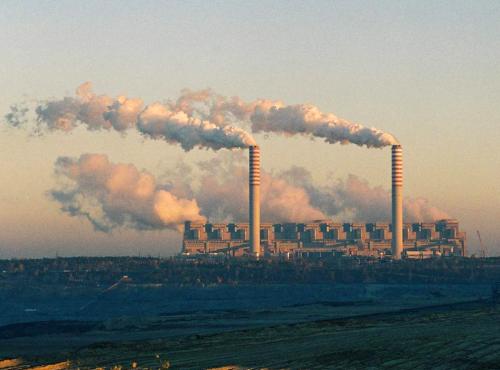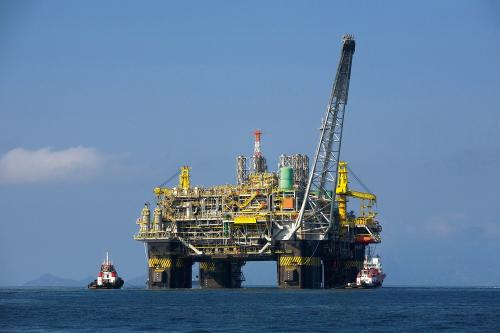Content from the Brookings Institution India Center is now archived. After seven years of an impactful partnership, as of September 11, 2020, Brookings India is now the Centre for Social and Economic Progress, an independent public policy institution based in India.
Editor’s Note: This article is excerpted from a speech given by Vikram Singh Mehta, chairman, Brookings India, at the Lovraj Kumar Memorial Lecture.
“The Future of Oil” is headed towards an interesting crossroad. The pathway will not be signposted; there will be many twists and turns. Oil is headed towards a future in which it will lose its pre-eminence in the energy landscape.
Key Highlights:
Over the next five years:
- Oil, along with coal and natural gas, will remain the bulwarks of the global energy system, providing the energy to fuel transportation, run industry, generate power and electrify homes.
- Oil rests currently on the pillar of mobility. Looking forward five years, this pillar will not be replaced by another fuel source.
- Don’t forsee the emergence of scalable or competitive alternatives to liquid fuels for transportation. Natural gas, CNG, LNG will not make a substantive dent.
- Our energy infrastructure for transport is built around liquid fuels. It will take many years and massive investment to create an alternative that can transport, distribute and market non-liquids.
- There is a huge latent demand for cars. As income levels rise and people move into urban settings, this demand will surface and the demand for oil will correspondingly rise.
- Oil is also pivotal to geo-political stability. To safeguard against the consequential implications caused by the diminishing significance of oil in the energy basket, most governments would prefer a slow and predictable transition to a non-oil energy system.
- The businesses of petroleum companies, petrochemical plants, automobile manufacturers, process industries are hard-wired around oil. They have a vested interest in prolonging its future.
In the long-term future:
- Global warming and the continuing advance of technology will definitively influence the longer term future of oil. Everyone agrees that the planet is warming and that no country can escape its consequences.
- Paris COP21 conference shows a common urgency to move economic growth onto a low carbon trajectory.
- Future of oil will also change with the technological explosion that has impacted every aspect of our lives.
- “Disruptive technology” could take the edge off many of the forces that have brought oil to its current pivotal position.
- Oil needs to keep pace with falling prices of renewable energy. Industry, residential homes, commercial establishments and electricity that currently account for 40% of the total global demand for oil will soon have the option to switch to competitive, reliable and cleaner non-oil alternatives.
- Oil (and coal) companies are facing a number of lawsuits holding them accountable for global warming. They could face the kind of public and legal pressure that tobacco companies faced years ago.
Dr Kelkar, Chairman of the Board of Trustees, Professor Vasudev, members of the Board of Trustees, former colleagues, friends, ladies and gentlemen, I am honoured today. More so than perhaps anyone in this audience other than Radha will appreciate. For Lovraj Kaka, which is what I called him, was more than one of my parents’ closest friends. He was my mentor and guided me at crucial moments in my life. He influenced my decision to apply to his alma mater Magdalen College at Oxford university. And as a result I received, what I still believe, is the finest liberal arts offering by a UK university – the politics , philosophy and economics degree and at what is arguably the most beautiful college campus in England.
Later when I abruptly handed in my resignation from the IAS after 19 months, hewas one of the very few who did not suggest I may have been affected by the heat of Rajasthan. I was at that time the assistant collector in Jaipur. I did not have another job and I did not have a plausible explanation to the question “why do you want to leave?”. I had been allotted my home state and I was enjoying my stint in the district. My fumbled responses cut no ice including with my father
who was himself a career bureaucrat. Also, given that I was still under probation, I was required to pay back the government my entire salary for 19 months. Lovraj did not probe and once he understood I was determined, he helped me define my next steps. Later, after four years with an American oil company Phillips Petroleum in the UK and the USA, when I expressed an interest in returning to India and to the public sector he steered me towards Dr Vijay Kelkar. So, you will appreciate why for me today is not just an ordinary day. To be invited to memorialise one of the great public servants of independent India is an honour in itself. To be asked to do so for a man with whom I had such a close personal association and with Dr Kelkar who had a deep impact on my career and for whom I have the greatest of respect in the Chair is honour in extremis. I thank the Trustees profoundly.
Oil vis-à-vis Climate Change and Technological Advancements
The subject “The Future of Oil” would have interested Lovraj. For he was always one step ahead of the curve. He sought to identify emergent trends; anticipate the unexpected and prepare for the unforeseen. He often posed the counterfactual “what if?”. Climate change and the advance of technology are the two counterfactuals that compel a non-linear reflection on today’s subject. Two questions need to be posed: What is the future of oil now that the debate on climate change is over and scientists and politicians are agreed that the planet is warming and that economic growth must be shifted onto a low carbon trajectory? And, what is the future of oil in the face of exponential technological progress and the efforts to create competitive and scalable alternatives to fossil fuels?
There is no easy answer to these questions but they do suggest that the “Future of Oil” is headed towards an interesting crossroad. It is not clear as to when it will reach this marker but when it does one direction will move it forward linearly and it will continue to dominate the energy market. The other will lead it into uncharted territory. The pathway will not be signposted; there will be many twists and turns and no one will quite know the specifics of the destination and when and how it will be reached. But everyone will know that oil is headed towards a future in which it will lose its pre-eminence in the energy landscape.
I want to reflect on both of these directions.
Oil as the Pillar of Mobility
In the short- to medium-term future—and let me assume for the sake of specificity, a five-year time period—I have no doubt oil will, along with coal and natural gas, dominate the energy basket. It will provide the energy to fuel transportation, run industry, generate power and electrify homes. It will remain one of the bulwarks of the global energy system. I say this with conviction because during this time period we will not see the emergence of scalable or competitive alternatives to liquid fuels for transportation.
Today the world consumes 91 million barrels a day of oil. The transportation sector which covers motor vehicles, airlines, inland waterways and ocean going ships absorbs nearly 60% of this number. The balance is consumed by industry (25%); residential homes and commercial properties (10%) and electricity (6%).
Oil rests, in other words, on the pillar of mobility.
Looking forward five years or so three realities stand out:
One, this pillar will not be replaced by another fuel source. Sure, natural gas will make further inroads through CNG and LNG. China is for instance already running 100,000 trucks on gas and the US is moving to open 100 LNG stations along its highways. Sure also, there is the possibility of bio diesel and bio ethanol as potential liquid substitutes. But neither of these alternatives will make a substantive dent within this time frame. Auto and truck manufacturers will have to modify engines to use natural gas, and petroleum companies will have to create the appropriate retail network. Bio fuels will also have to overcome similar technology and infrastructure related hurdles but in addition they will face competition from agriculture. The cellulosic option that does not compete with food is expensive and cannot be produced in bulk. (I should add that ethanol contains only about 70% of the energy relative to gasoline.)
Second, it will not be possible to create a non-liquids fuel based mobility infrastructure within this time period. I am reminded of the time it took for American factories to convert from steam power to electric power. Thomas Edison illuminated the lower half of Manhattan sometime in the mid-1880s. But it was not until the mid-1930s that the factories in the mid-west of America had converted to electric power. It took them so long to accept this revolutionary new technology because they had to be redesigned and in some cases completely rebuilt. The fact is that our energy infrastructure for transport is built around liquid fuels. It will take many years and massive investment to create an alternative that can transport, distribute and market non-liquids.
Third, 2.5 billion people live in countries where on average 1 person in 50 owns a car. The ratio in China is 50 cars per 1000 people; in India it is 12 per 1000. This is in comparison to 500 cars per 1000 in OECD countries. Ownership of cars is a hallmark of middle class standing. Those of us who have to navigate the traffic congestion of our roads may wish for tighter regulation on car ownership. But that is a self-serving wish. The reality is that millions wish to trade up from a cycle to a two-wheeler to eventually a car. There is a huge latent demand for cars and as income levels rise and people move into urban settings, this demand will surface and the demand for oil will correspondingly rise. OPEC and BP have estimated separately the demand for oil increasing from 91 million barrels a day today to 111 million barrels by 2035. They expect that this incremental demand will come mainly from China, India and the Middle East and that 89% of the fuel demand for transportation will be met from liquids and the balance 11% from alternatives predominantly natural gas.
These three realities provide the structural underpinnings for the argument that oil will continue to dominate the energy basket in the short term. There are in addition two geo-economic drivers: The bulk of the reserves of conventional and relatively low cost oil are concentrated in a handful of countries in the Gulf, Iran, Iraq, Nigeria, Russia and one or two others. These countries are almost totally dependent on oil and in the face of low oil prices they are facing huge internal financial, economic and social challenges. The IMF has, for instance, estimated that if the price of oil hovers around USD 50 a barrel, the five Gulf countries (Saudi, Qatar, Kuwait, Oman and Bahrain) will face an accumulated deficit of USD 700 billion by 2020. Five years back they had a combined surplus of USD 600 billion. The Russian economy is on the skids; Nigeria is driven by civil strife and Venezuela may well be headed towards a coup. The point is that oil is pivotal to geo-political stability. Political and social upheaval caused by the diminishing significance of oil in the energy basket will have global ramifications and so if for no other reason than to safeguard against the consequential implications (especially in light of the spread of fundamentalism and extremism) most governments would (and perhaps should) prefer a slow and predictable transition to a non-oil energy system. To that extent there is an inherent geopolitical dynamic in support of oil.
Businesses reinforce this dynamic. The petroleum companies, the petrochemical plants, the automobile manufacturers, the process industries have billions invested in the oil economy. Their business interests are hard wired around this commodity and they have a vested interest in prolonging its future.
Oil and Climate Change
My argument so far has been set within a short term framework. During this period I do not foresee a significant shift in oil’s position in the energy basket. I see it as proceeding along a linear pathway. But looking beyond this time frame I can picture a possibly different future. I can see oil moving off the linear pathway and onto uncharted territory. This is not a prediction but in the tradition of scenario planning a description of an alternative future.
Let me sketch the contours of such a picture.
Two forces will definitively influence the longer term future of oil. These are global warming and the continuing advance of technology .
On May 6, 2014 the New York Times published on its front page the declaration of the US Climate Association. This association comprises 60 people including representatives from the oil companies. The declaration stated that “climate change once considered an issue for the distant future has moved firmly into the present”. It projected that mean sea levels would rise between 1 and 4 feet by 2100 if the current rate of emissions of greenhouse gases (GHG) is not arrested.
The low lying regions of the world including India which has a 7000 kms long coastline with 150 million people living alongside would be severely impacted.
More recently President Obama cancelled the Keystone XL pipeline project. This was a proposal to move 800,000 barrels a day of tar sand oil from Alberta in Canada to the US Gulf Coast refineries. In explaining his decision, the President said, “Ultimately if we are going to prevent large parts of the Earth from becoming not only inhospitable but uninhabitable in our lifetime we are going to have to keep some fossil fuels in the ground rather than burn them and release more dangerous pollution into the sky.”
The declaration of the Association and President Obama’s statement brings one fact into sharp relief. There is now no dissonant message regards global warming. Everyone agrees that the planet is warming and that no country can escape its consequences. Leaders may not vocalise their concerns for political reasons but they all appreciate that they must put their weight behind a green agenda. In the run up to COP 21 in Paris almost every country (145 at the time of writing) has announced their “intended nationally determined contributions” (INDC’s) towards containing carbon emissions. China has announced it will reduce carbon intensity by 60-65% by 2030 from 2005 and increase the share of non-fossil fuel energy in total primary energy supply to 20%; the US has said it will reduce emissions to between 26 and 28% below 2005 levels by 2025 and India that it will cut back by between 33 and 35% by 2030 and that subject to technological and financial support from the international community it will produce 40% of its energy from non-fossil fuels.
These commitments are not enough to keep temperatures from rising by more than 2 degree centigrade—the level that scientists state would push us over the edge and it remains to be seen whether the political will exists to execute an agreement in Paris that will compel countries to go beyond vaguely formulated targets and accept the obligation of differentiated responsibility but it does reflect perhaps for the first since this issue came onto the international agenda a common urgency to move economic growth onto a low carbon trajectory.
The second pre-determined force is the continuing advance of technology. It’s advance so far has been exponential and transformational. Moore (Gordon Moore, co-founder of Intel and Fairchild Semiconductor) gave us a hint of what to expect but I doubt anyone foresaw the dramatic impact of compounding. Moore’s law, as I am sure most of you know, posited that computing power would double every 18-24 months. To fully grasp its implications, imagine you drove your car at 5 miles an hour for the first minute, then at 10 miles an hour for the second minutes and thereafter you doubled the speed every minute. In the first minute you would have covered 440 feet, in the second 1760 feet and at 80 miles an hour in the 5th minute you would have done just over a mile. Now imagine that this speed is doubled 27 times which is the number of times that computing power has doubled since 1958 when the integrated circuit board first made its appearance. Your speed would be 617 million miles an hour and you could reach Mars in 5 minutes or so.
My point is simple: Technology has exploded not because of one-off discrete innovations but because each breakthrough has built on what has been achieved before. Technology has followed what Ray Kurzweil, the innovator, with perhaps more patents to his name than anyone else, refers to as the “law of accelerating returns”. This explosion has impacted not just computers and electronics. It has impacted every aspect of our lives.
Looking forward, we should assume that this “law of accelerating returns” will prevail. That we will continue to see disruptive change. That we will continue to be surprised. In this vein, I can see “disruptive technology” taking the edge off many of the forces that have brought oil to its current pivotal position.
A Warming Planet Needs a Different Model for Mobility
Technology could render the internal combustion engine obsolete. Hybrids and electric vehicles have already made their appearance. Tesla, the EV company, has acquired near iconic status and whilst its share price is substantially down from the peak levels of a couple of years ago because of the fall in oil prices it is still moving fast forward towards building a broader customer base. Many hurdles have of course yet to be overcome. The cars are expensive, battery and storage technology limit the range it can travel, the “plug in” infrastructure has to be put in place and the consumer has yet to be persuaded. Last year for instance only 300,000 EV/hybrids were sold, compared with 82 million IC cars. However, these are not insuperable hurdles and as and when, not if and when, these are crossed the impact would be game changing. Next “smart mobility”, “smart infrastructure”, ” and “smart economics ” could upend the current ” owner-operator model for cars with downward implications for the demand for oil.
Today people own cars part because they enjoy driving, part because of need and part because it signals their status in society. Purchase is an act of individuality and reflects aspiration, values, and taste. Cars are however an inherently inefficient asset. They are idle for almost 90% of the time in parking lots, garages or along the roadside. They take up scarce urban land and are a major contributor to air pollution. There are, in short, powerful economic, social and environmental reasons for changing the current owner-operator model.
Today there is lot of work underway to develop an alternative model. The Pentagon catalysed this development. They were interested in developing robotic military vehicles and towards that objective they sponsored a race between 15 robotic vehicles on March 13 2004. The prize money was USD 1 million for the first vehicle that crossed 150 miles of the Mojave desert in California. The result was not impressive. None of the vehicles managed to complete even 10% of the route. The following year in October 2005 the Pentagon organised a second race. This time they offered USD 2 million. The route was more complex. It involved navigating mountain passes with sheer drop offs on either side, hairpin turns and three tunnels. The results were astonishingly impressive. Five vehicles completed the course.
The idea of driverless cars was picked up by Google in 2008. The Chairman of Google, Sergei Brin, was of the view that cars should be seen as a commodity and not a luxury purchase and that smart technology could be harnessed to improve the efficiency of utilisation of this asset and also unlock the value of scarce urban land. His vision was to commercialise “driverless” or “autonomous” cars and to thereby undermine the owner- operator model. Brin hired the best brains including many of the scientists that had worked on the Pentagon project. The Google project has to-date made significant progress. Their driverless cars have driven over 300,000 accident-free miles. It has also galvanised all the leading car manufacturers to invest in robotic, autonomous and semi-autonomous models. None have so far introduced a model—they have less incentive to do so—but Mercedes’ latest S class model does have the software to drive “autonomously ” in stop-go traffic and on an autobahn at up to 120 miles an hour.
In a separate but related front we are seeing the onset of “on line” mobility services. Uber is a good example of an emergent trend. The millennials (people born between 1985 and 1995) are increasingly using their smart phones to access mobility than investing in an owned and inherently inefficient asset. Both developments—the driverless car and shared mobility—will reduce the demand of cars per capita and the number of cars on the road.
But here again I do not wish to run ahead of myself. The owner-operator model is not going to be overturned soon. Cars are integral to personal identity and attitudes will have to change fundamentally before people give up the idea of ownership and regard them as items of utility. A change in the current model will also raise legal, insurance and safety issues. And it will trigger the resistance of incumbent interest groups whose businesses area threatened. Uber has had to fight off lawsuits in every market it has entered and that from only one interest group: the cab drivers. A change in the current model will provoke the opposition of a multiple of interest groups—the oil companies, the car dealers, repair shops and petrol stations.
Keynes said nothing can hold back an idea whose day has come. The idea that a warming planet needs a different model for mobility is taking root. There are no insuperable hurdles and perhaps the day is not far off when to use the acronym coined by the scientist Amory Lovins PIGS will give way to SEALS. PIGS is the acronym for “personal internal combustion gasoline and steel dominated vehicles”. And SEALS the acronym for “shared, electrified, autonomous, lightweight service vehicles”.
A third force is renewable energy, in particular solar and wind. This sector has made extraordinary progress. Wind accounted for 17 GW of global energy supply in 2000 and solar a mere 1.4 GW. Last year in 2014 wind contributed 283 GW, a 16-fold increase, and solar 100 GW a 70-fold increase. Wind- and solar-based power generation has grown at double-digit rates for 11 consecutive years. In 2014 it increased capacity by 12% over 2013 and accounted for 42.5% of the incremental growth in global power generation and 28% of the incremental growth in energy demand over that 12-month period. It attracted approximately USD 300 billion of investment in 2014 as against USD 5 billion in 2000.
Nuclear is also now stirring itself. Fukushima hit the industry severely and the build rate of nuclear reactors in recent years has been modest. There are at present 67 reactors under construction. This will add only 15 GW per annum. However, a new generation of passive safety reactors are under design and this might boost the momentum. The drivers behind the success of renewables has been technology and policy.
Technology has reduced the cost of panels, inverters, turbines etc. to the extent that wind and solar are today competitive against oil. There are many calculations and one should be wary of citing cost figures because so much depends on context, location and above ground issues like land acquisition, approval processes and infrastructure. But to illustrate the point herewith, the numbers produced by the investment bank Lazards. According to them the levellised cost (ie. average long-run cost) range for wind power in the US is between US 3.7 cents to 8.1 cents / kWh and for thin film solar power from US 7.2 cents to 8.6 cents / kWh. The comparable cost of electricity from oil prices at USD 50 / bbl would be around 14 cents / kWh. The price of oil would have to fall to around USD 15 / bbl for it to be competitive.
Government and regulatory policies have reinforced this technology-driven cost competitiveness. Many countries have introduced fiscal, investment and market incentives like green certificates, carbon markets, subsidies, tax credits and emission targets. Some have legislated strict time-bound targets for shifting towards renewables. The state of California, which has for long set the marker for other states to follow, has effectively mandated that all surface transport and grid electricity must be powered by either renewables or nuclear by 2050.
Wind and solar are today niche contributors through distributed and dispersed models. The technology for battery storage will have to be improved, the grid upgraded and, in countries like ours, the distribution companies recapitalised before they can make a major dent. But as in the case of EVs and autonomous driverless cars, the law of accelerating returns would suggest that these improvements and upgradations are but a matter of time. What one has to internalise is the fact that industry, residential homes, commercial establishments and electricity that currently account for 40% of the total global demand for oil will sooner than later have the option to switch to competitive, reliable and cleaner non-oil alternatives.
I have so far talked of the three forces that might knock out the props of oil demand. Let me add to that one supply-driven prop that is also weakening: The integrated multinational petroleum companies. I believe their business model is under severe threat. They are in a business that requires huge upfront capital investment but they see returns only after decades. They have no control over the market and in particular the price of oil. They face increasing competition because information technology has made it easier for smaller, specialised companies to enter and compete across every segment of their value chain; they have limited or no access to “easy” low-cost oil as those reserves are owned by state-owned companies like Saudi Aramco and Kuwait national oil company. They confront the prospect of stranded economic assets as not only has the decline in the price of oil rendered many of their investments unviable but governments are increasingly denying them the right to monetise their assets. President Obama’s decision on the Keystone pipeline is indicative of this approach and Shell has recently declared its worst results in years. It declared a loss of USD 6.1 billion dollars in the third quarter of 2015 compared with a profit of USD 5.1 billion in the comparable quarter of last years. Part of the reason was the fall in oil prices but a major cause is the impairment charge on its investments in the Arctic and Canada. The latter have been embroiled in regulatory and environmental pressure.
Finally and perhaps most important: oil companies face increasing public scrutiny. They are caught in the climate change crossfire. Recently the New York Attorney-General subpoenaed Exxon to explain the charge that it had sought to bury the results of a study on climate change. Oil (and coal) companies are facing a number of lawsuits holding them accountable for global warming. None have been upheld but the pressure is clearly mounting and the day cannot be far off when they face the kind of public and legal pressure that tobacco companies faced years ago.
In conclusion I need to repeat. I am not offering a prediction about the future of oil. I am merely outlining emergent trends. Oil does of course have a future. It is available in abundance. And in some countries like India that are arguably entering the most energy-intensive phase of economic growth with prosperity enhancing the demand for motorised vehicles and the “make in India” policy increasing the share of manufacturing in GDP, this future could be robust. But one must not assume that the future will progress linearly. The convergence of technology and global warming is pushing oil towards a crossroads and that as and when it reaches that point it is possible that the combined weight of Moore’s law and Kurzweils “law of accelerating returns” will see it take an abrupt and unforeseen turn off the beaten track. Such a turn could lead to a dramatic and transformationally different future.
Recently I saw two photographs published side by side of the Easter parade in New York. The first photograph was taken in 1900. The second in 1913. Looking at the first you had to strain your eyes to see the first car. Looking at the second you had difficulty locating the last horse. I doubt oil will be so difficult to locate—it will remain in the interstices of our energy system—but we should be prepared to move beyond the language of the present to describe its future significance.











Commentary
Op-edWill oil remain the bulwark of global energy system in the long-term?
November 26, 2015